BSBMKG512: Business Report on Live Export of Cattle in Australia
VerifiedAdded on 2023/06/14
|20
|3243
|80
Report
AI Summary
This report analyzes the live export of cattle in Australia, a significant player in the global beef market. It highlights Australia's position as a major exporter, particularly to Indonesia, Vietnam, and China, while also addressing challenges like droughts and regulatory hurdles. The report delves into market intelligence, networking opportunities, and key statistics, including trade volumes and values. It examines the economics of the industry, distribution channels, and key success factors. Furthermore, it explores trends, legal and ethical constraints, and environmental issues impacting the industry, including the impact of droughts and trade barriers. A SWOT analysis provides insights into the industry's strengths, weaknesses, opportunities, and threats. The report also identifies new target markets and recommends forecasting techniques for future planning. Desklib provides access to this and other solved assignments for students.
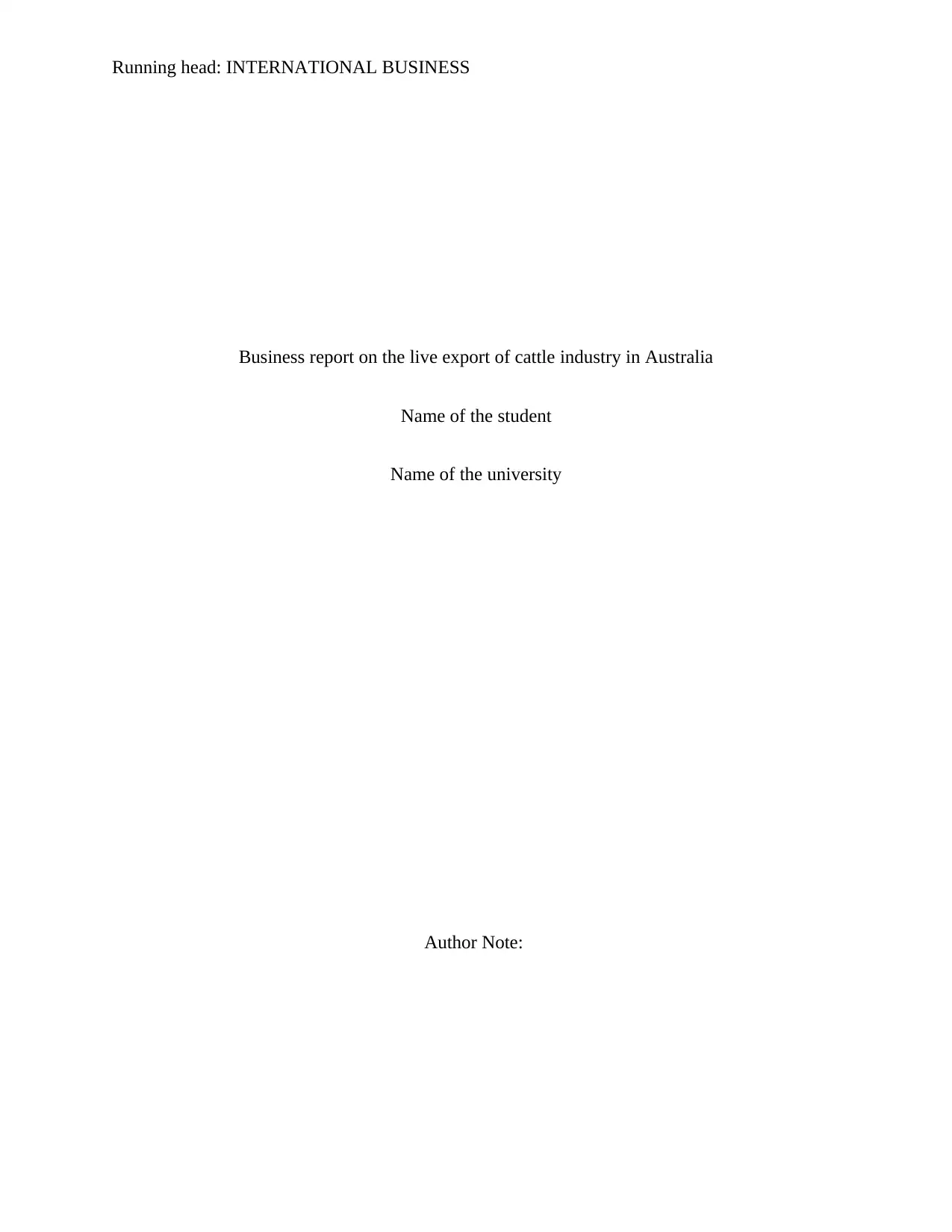
Running head: INTERNATIONAL BUSINESS
Business report on the live export of cattle industry in Australia
Name of the student
Name of the university
Author Note:
Business report on the live export of cattle industry in Australia
Name of the student
Name of the university
Author Note:
Paraphrase This Document
Need a fresh take? Get an instant paraphrase of this document with our AI Paraphraser

2
INTERNATIONAL BUSINESS
Table of Contents
Introduction......................................................................................................................................4
Section 1..........................................................................................................................................4
Target Market..................................................................................................................................4
Sources of Market Intelligence........................................................................................................4
Networking Opportunities...............................................................................................................5
Statistics...........................................................................................................................................5
Main Trade Fairs on Cattle..............................................................................................................6
Collaboration and Analysis of current markets...............................................................................6
Market Growth Rate........................................................................................................................6
Figure 1-: Graph showing uneven distribution of Rainfall in Australia..........................................7
Market Profitability.........................................................................................................................7
New Regulatory Requirements........................................................................................................7
Economics of the Australian Live Export Industry.........................................................................7
Distribution Channels......................................................................................................................8
Figure 2-: Distribution Channels of Beef and Cattle in Australia...................................................8
Key Success Factors........................................................................................................................9
Section 2..........................................................................................................................................9
Trends and Developments and their Impacts...................................................................................9
INTERNATIONAL BUSINESS
Table of Contents
Introduction......................................................................................................................................4
Section 1..........................................................................................................................................4
Target Market..................................................................................................................................4
Sources of Market Intelligence........................................................................................................4
Networking Opportunities...............................................................................................................5
Statistics...........................................................................................................................................5
Main Trade Fairs on Cattle..............................................................................................................6
Collaboration and Analysis of current markets...............................................................................6
Market Growth Rate........................................................................................................................6
Figure 1-: Graph showing uneven distribution of Rainfall in Australia..........................................7
Market Profitability.........................................................................................................................7
New Regulatory Requirements........................................................................................................7
Economics of the Australian Live Export Industry.........................................................................7
Distribution Channels......................................................................................................................8
Figure 2-: Distribution Channels of Beef and Cattle in Australia...................................................8
Key Success Factors........................................................................................................................9
Section 2..........................................................................................................................................9
Trends and Developments and their Impacts...................................................................................9
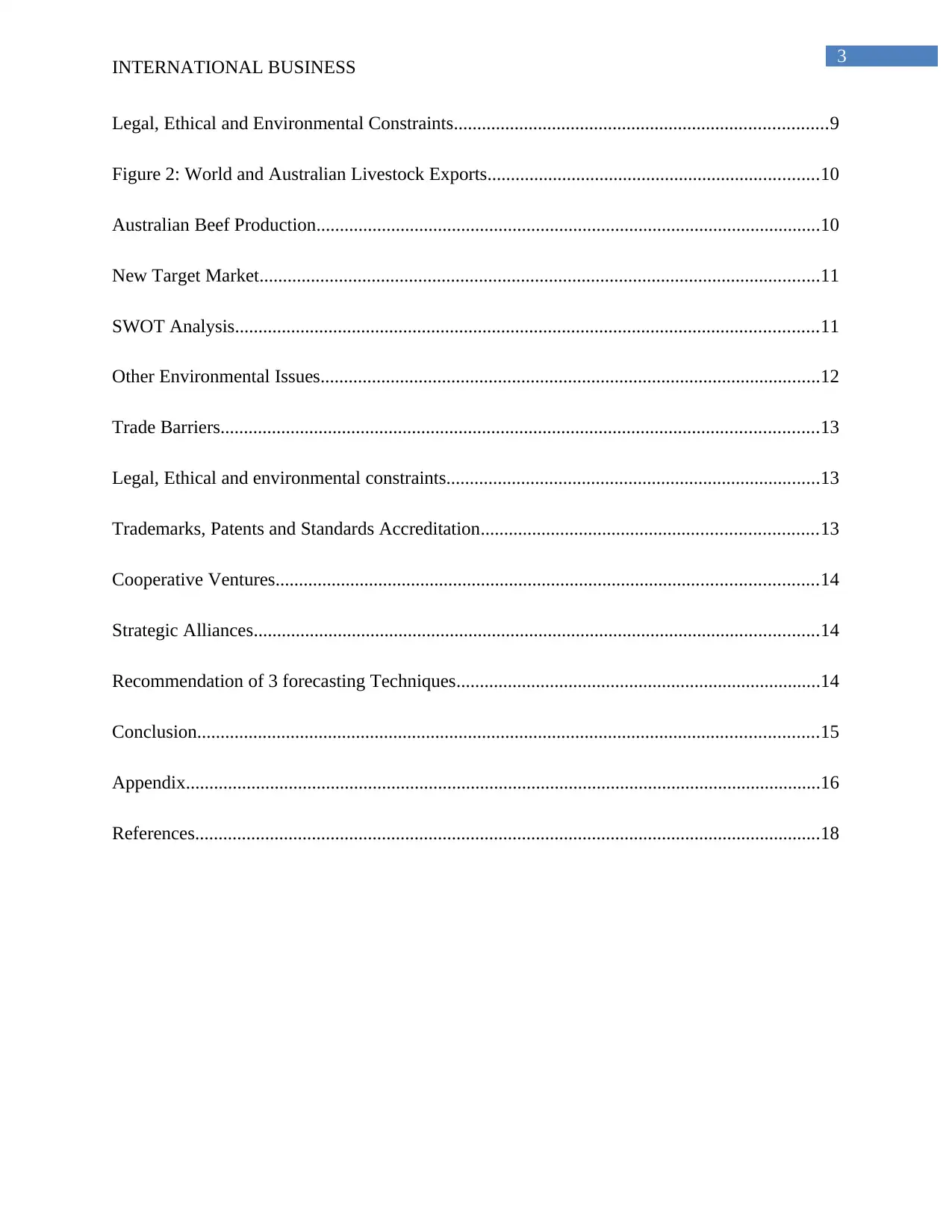
3
INTERNATIONAL BUSINESS
Legal, Ethical and Environmental Constraints................................................................................9
Figure 2: World and Australian Livestock Exports.......................................................................10
Australian Beef Production............................................................................................................10
New Target Market........................................................................................................................11
SWOT Analysis.............................................................................................................................11
Other Environmental Issues...........................................................................................................12
Trade Barriers................................................................................................................................13
Legal, Ethical and environmental constraints................................................................................13
Trademarks, Patents and Standards Accreditation........................................................................13
Cooperative Ventures....................................................................................................................14
Strategic Alliances.........................................................................................................................14
Recommendation of 3 forecasting Techniques..............................................................................14
Conclusion.....................................................................................................................................15
Appendix........................................................................................................................................16
References......................................................................................................................................18
INTERNATIONAL BUSINESS
Legal, Ethical and Environmental Constraints................................................................................9
Figure 2: World and Australian Livestock Exports.......................................................................10
Australian Beef Production............................................................................................................10
New Target Market........................................................................................................................11
SWOT Analysis.............................................................................................................................11
Other Environmental Issues...........................................................................................................12
Trade Barriers................................................................................................................................13
Legal, Ethical and environmental constraints................................................................................13
Trademarks, Patents and Standards Accreditation........................................................................13
Cooperative Ventures....................................................................................................................14
Strategic Alliances.........................................................................................................................14
Recommendation of 3 forecasting Techniques..............................................................................14
Conclusion.....................................................................................................................................15
Appendix........................................................................................................................................16
References......................................................................................................................................18
⊘ This is a preview!⊘
Do you want full access?
Subscribe today to unlock all pages.

Trusted by 1+ million students worldwide
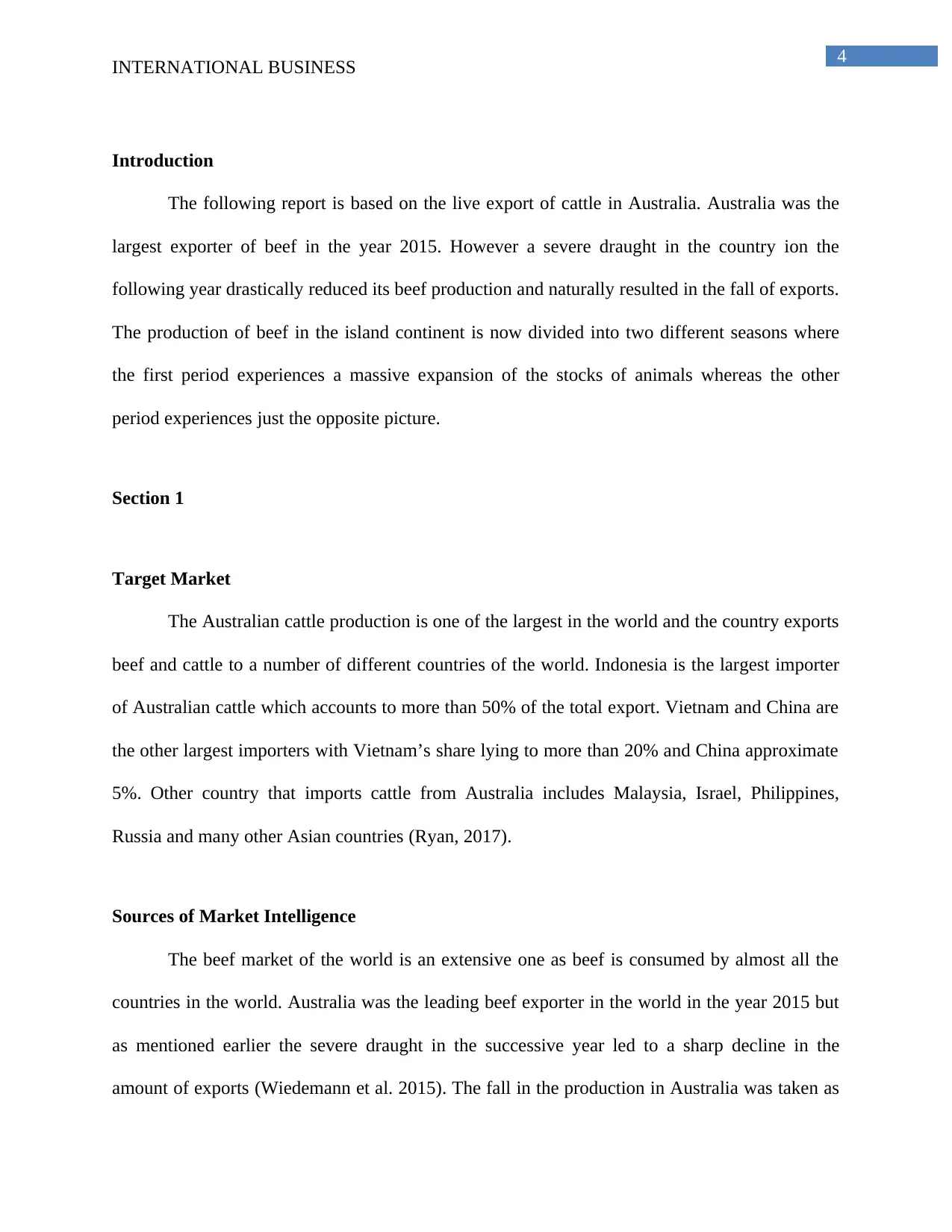
4
INTERNATIONAL BUSINESS
Introduction
The following report is based on the live export of cattle in Australia. Australia was the
largest exporter of beef in the year 2015. However a severe draught in the country ion the
following year drastically reduced its beef production and naturally resulted in the fall of exports.
The production of beef in the island continent is now divided into two different seasons where
the first period experiences a massive expansion of the stocks of animals whereas the other
period experiences just the opposite picture.
Section 1
Target Market
The Australian cattle production is one of the largest in the world and the country exports
beef and cattle to a number of different countries of the world. Indonesia is the largest importer
of Australian cattle which accounts to more than 50% of the total export. Vietnam and China are
the other largest importers with Vietnam’s share lying to more than 20% and China approximate
5%. Other country that imports cattle from Australia includes Malaysia, Israel, Philippines,
Russia and many other Asian countries (Ryan, 2017).
Sources of Market Intelligence
The beef market of the world is an extensive one as beef is consumed by almost all the
countries in the world. Australia was the leading beef exporter in the world in the year 2015 but
as mentioned earlier the severe draught in the successive year led to a sharp decline in the
amount of exports (Wiedemann et al. 2015). The fall in the production in Australia was taken as
INTERNATIONAL BUSINESS
Introduction
The following report is based on the live export of cattle in Australia. Australia was the
largest exporter of beef in the year 2015. However a severe draught in the country ion the
following year drastically reduced its beef production and naturally resulted in the fall of exports.
The production of beef in the island continent is now divided into two different seasons where
the first period experiences a massive expansion of the stocks of animals whereas the other
period experiences just the opposite picture.
Section 1
Target Market
The Australian cattle production is one of the largest in the world and the country exports
beef and cattle to a number of different countries of the world. Indonesia is the largest importer
of Australian cattle which accounts to more than 50% of the total export. Vietnam and China are
the other largest importers with Vietnam’s share lying to more than 20% and China approximate
5%. Other country that imports cattle from Australia includes Malaysia, Israel, Philippines,
Russia and many other Asian countries (Ryan, 2017).
Sources of Market Intelligence
The beef market of the world is an extensive one as beef is consumed by almost all the
countries in the world. Australia was the leading beef exporter in the world in the year 2015 but
as mentioned earlier the severe draught in the successive year led to a sharp decline in the
amount of exports (Wiedemann et al. 2015). The fall in the production in Australia was taken as
Paraphrase This Document
Need a fresh take? Get an instant paraphrase of this document with our AI Paraphraser
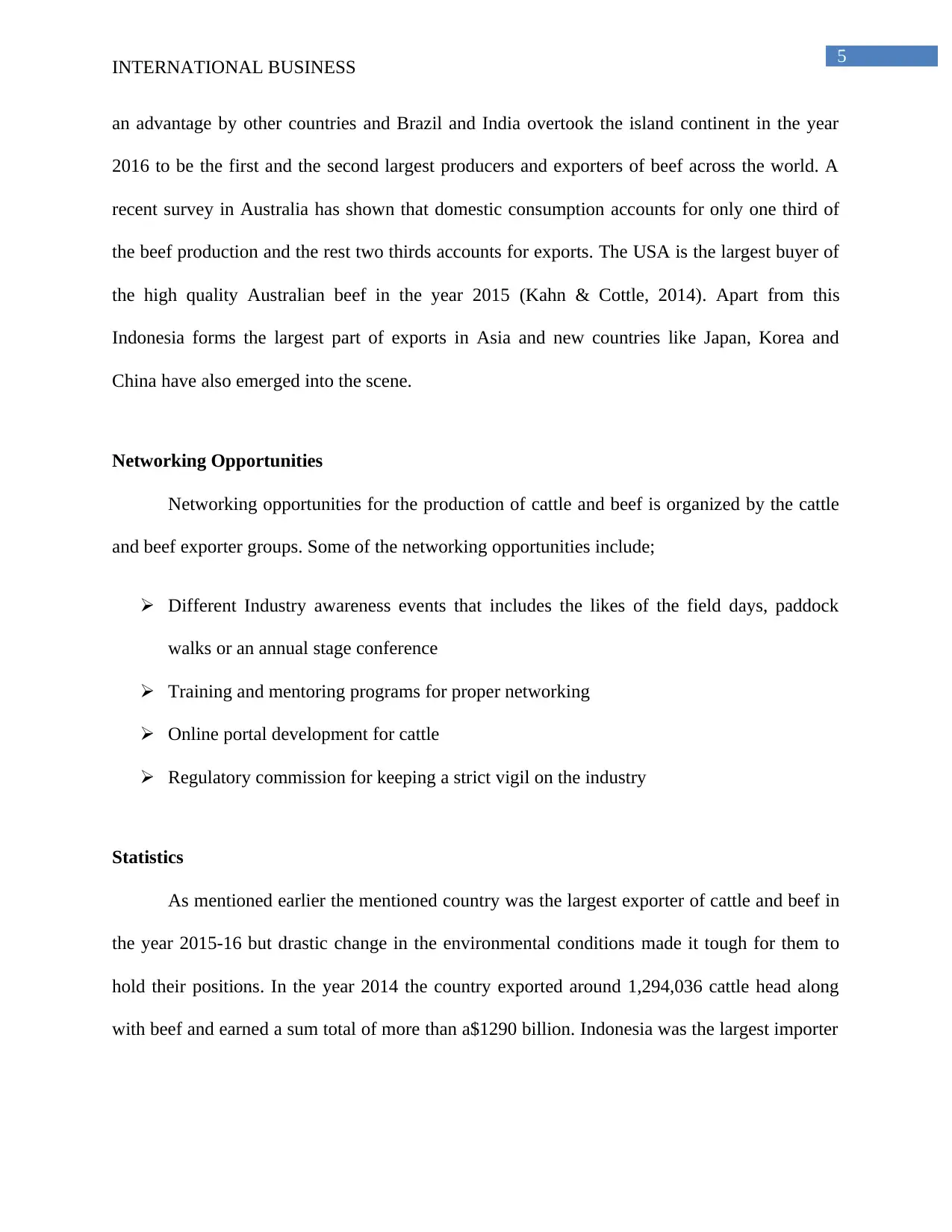
5
INTERNATIONAL BUSINESS
an advantage by other countries and Brazil and India overtook the island continent in the year
2016 to be the first and the second largest producers and exporters of beef across the world. A
recent survey in Australia has shown that domestic consumption accounts for only one third of
the beef production and the rest two thirds accounts for exports. The USA is the largest buyer of
the high quality Australian beef in the year 2015 (Kahn & Cottle, 2014). Apart from this
Indonesia forms the largest part of exports in Asia and new countries like Japan, Korea and
China have also emerged into the scene.
Networking Opportunities
Networking opportunities for the production of cattle and beef is organized by the cattle
and beef exporter groups. Some of the networking opportunities include;
Different Industry awareness events that includes the likes of the field days, paddock
walks or an annual stage conference
Training and mentoring programs for proper networking
Online portal development for cattle
Regulatory commission for keeping a strict vigil on the industry
Statistics
As mentioned earlier the mentioned country was the largest exporter of cattle and beef in
the year 2015-16 but drastic change in the environmental conditions made it tough for them to
hold their positions. In the year 2014 the country exported around 1,294,036 cattle head along
with beef and earned a sum total of more than a$1290 billion. Indonesia was the largest importer
INTERNATIONAL BUSINESS
an advantage by other countries and Brazil and India overtook the island continent in the year
2016 to be the first and the second largest producers and exporters of beef across the world. A
recent survey in Australia has shown that domestic consumption accounts for only one third of
the beef production and the rest two thirds accounts for exports. The USA is the largest buyer of
the high quality Australian beef in the year 2015 (Kahn & Cottle, 2014). Apart from this
Indonesia forms the largest part of exports in Asia and new countries like Japan, Korea and
China have also emerged into the scene.
Networking Opportunities
Networking opportunities for the production of cattle and beef is organized by the cattle
and beef exporter groups. Some of the networking opportunities include;
Different Industry awareness events that includes the likes of the field days, paddock
walks or an annual stage conference
Training and mentoring programs for proper networking
Online portal development for cattle
Regulatory commission for keeping a strict vigil on the industry
Statistics
As mentioned earlier the mentioned country was the largest exporter of cattle and beef in
the year 2015-16 but drastic change in the environmental conditions made it tough for them to
hold their positions. In the year 2014 the country exported around 1,294,036 cattle head along
with beef and earned a sum total of more than a$1290 billion. Indonesia was the largest importer
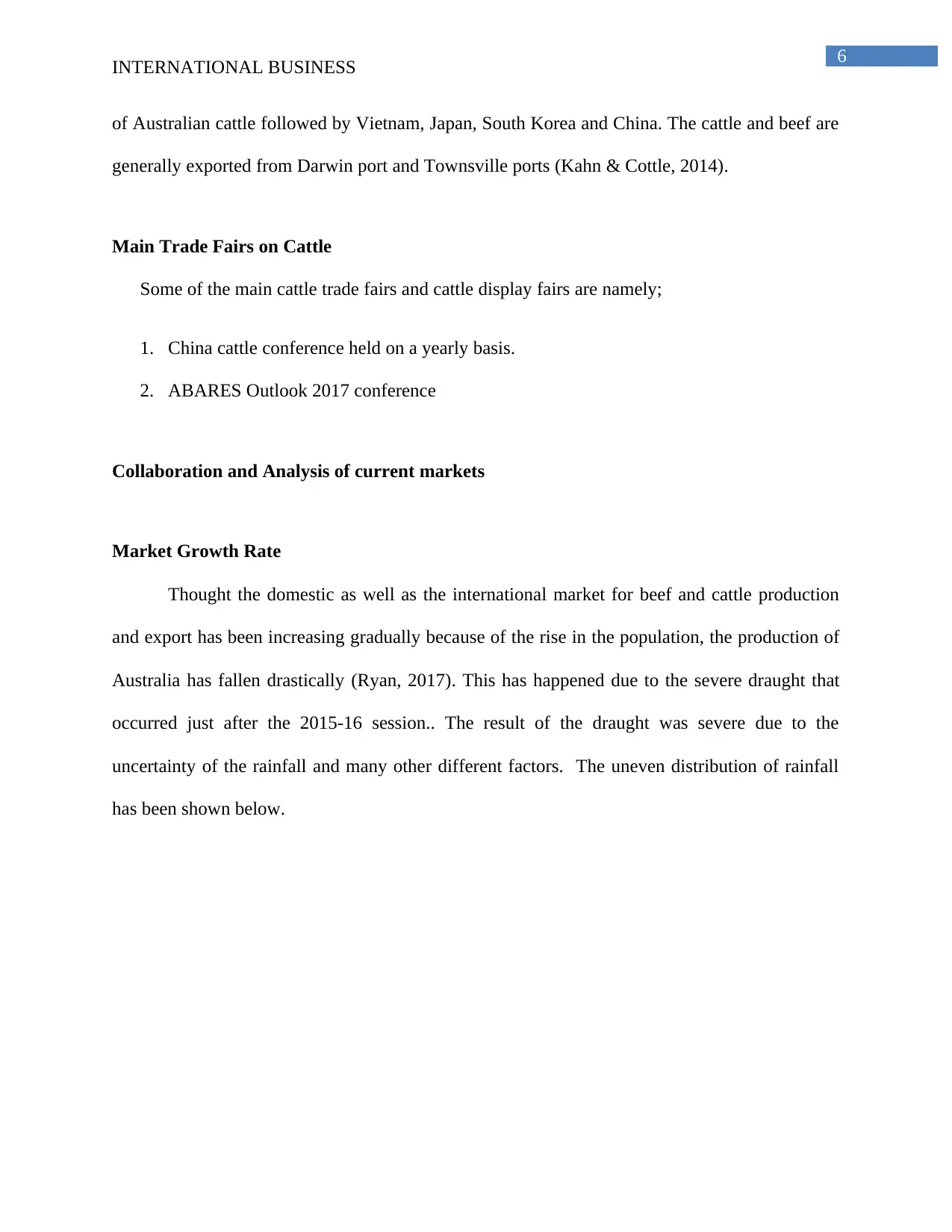
6
INTERNATIONAL BUSINESS
of Australian cattle followed by Vietnam, Japan, South Korea and China. The cattle and beef are
generally exported from Darwin port and Townsville ports (Kahn & Cottle, 2014).
Main Trade Fairs on Cattle
Some of the main cattle trade fairs and cattle display fairs are namely;
1. China cattle conference held on a yearly basis.
2. ABARES Outlook 2017 conference
Collaboration and Analysis of current markets
Market Growth Rate
Thought the domestic as well as the international market for beef and cattle production
and export has been increasing gradually because of the rise in the population, the production of
Australia has fallen drastically (Ryan, 2017). This has happened due to the severe draught that
occurred just after the 2015-16 session.. The result of the draught was severe due to the
uncertainty of the rainfall and many other different factors. The uneven distribution of rainfall
has been shown below.
INTERNATIONAL BUSINESS
of Australian cattle followed by Vietnam, Japan, South Korea and China. The cattle and beef are
generally exported from Darwin port and Townsville ports (Kahn & Cottle, 2014).
Main Trade Fairs on Cattle
Some of the main cattle trade fairs and cattle display fairs are namely;
1. China cattle conference held on a yearly basis.
2. ABARES Outlook 2017 conference
Collaboration and Analysis of current markets
Market Growth Rate
Thought the domestic as well as the international market for beef and cattle production
and export has been increasing gradually because of the rise in the population, the production of
Australia has fallen drastically (Ryan, 2017). This has happened due to the severe draught that
occurred just after the 2015-16 session.. The result of the draught was severe due to the
uncertainty of the rainfall and many other different factors. The uneven distribution of rainfall
has been shown below.
⊘ This is a preview!⊘
Do you want full access?
Subscribe today to unlock all pages.

Trusted by 1+ million students worldwide
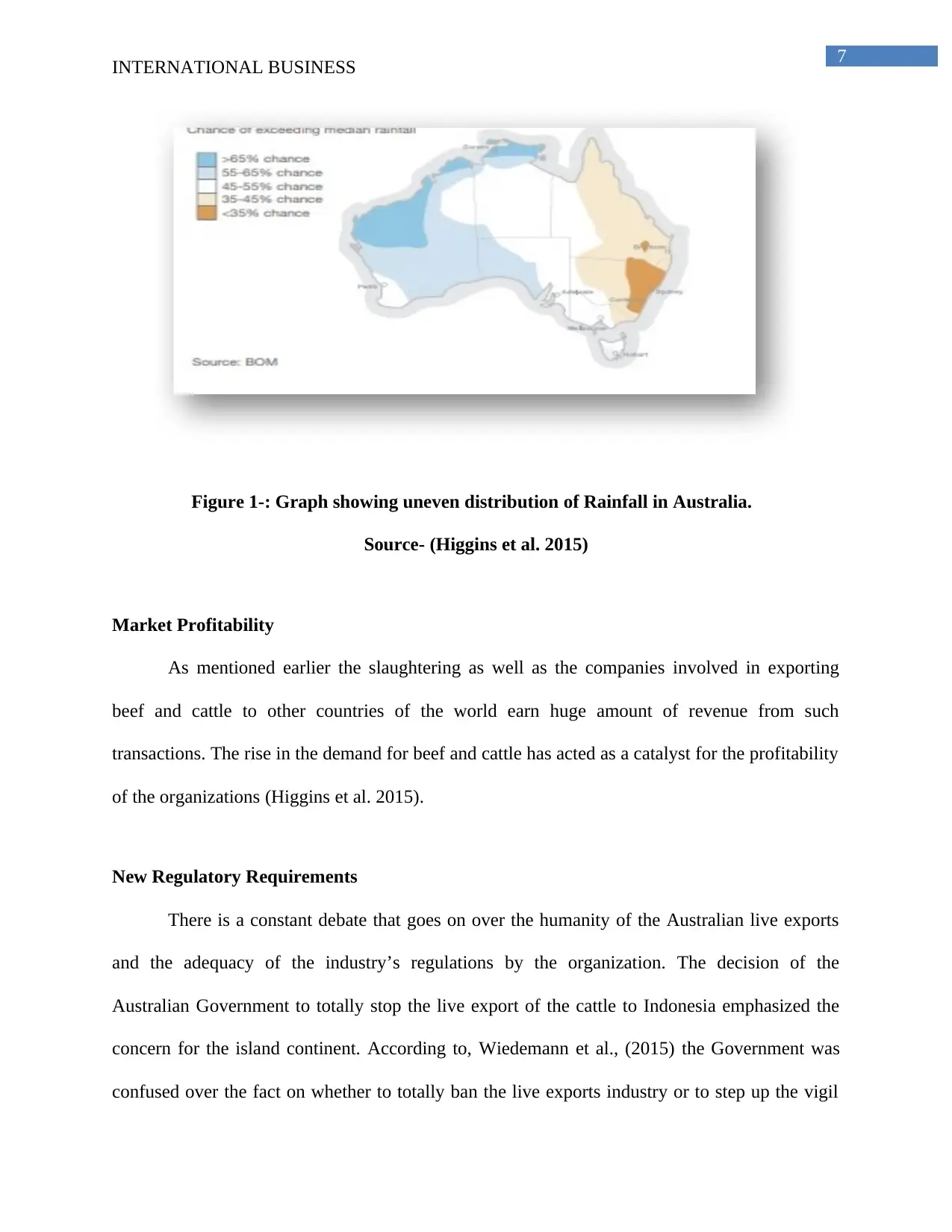
7
INTERNATIONAL BUSINESS
Figure 1-: Graph showing uneven distribution of Rainfall in Australia.
Source- (Higgins et al. 2015)
Market Profitability
As mentioned earlier the slaughtering as well as the companies involved in exporting
beef and cattle to other countries of the world earn huge amount of revenue from such
transactions. The rise in the demand for beef and cattle has acted as a catalyst for the profitability
of the organizations (Higgins et al. 2015).
New Regulatory Requirements
There is a constant debate that goes on over the humanity of the Australian live exports
and the adequacy of the industry’s regulations by the organization. The decision of the
Australian Government to totally stop the live export of the cattle to Indonesia emphasized the
concern for the island continent. According to, Wiedemann et al., (2015) the Government was
confused over the fact on whether to totally ban the live exports industry or to step up the vigil
INTERNATIONAL BUSINESS
Figure 1-: Graph showing uneven distribution of Rainfall in Australia.
Source- (Higgins et al. 2015)
Market Profitability
As mentioned earlier the slaughtering as well as the companies involved in exporting
beef and cattle to other countries of the world earn huge amount of revenue from such
transactions. The rise in the demand for beef and cattle has acted as a catalyst for the profitability
of the organizations (Higgins et al. 2015).
New Regulatory Requirements
There is a constant debate that goes on over the humanity of the Australian live exports
and the adequacy of the industry’s regulations by the organization. The decision of the
Australian Government to totally stop the live export of the cattle to Indonesia emphasized the
concern for the island continent. According to, Wiedemann et al., (2015) the Government was
confused over the fact on whether to totally ban the live exports industry or to step up the vigil
Paraphrase This Document
Need a fresh take? Get an instant paraphrase of this document with our AI Paraphraser
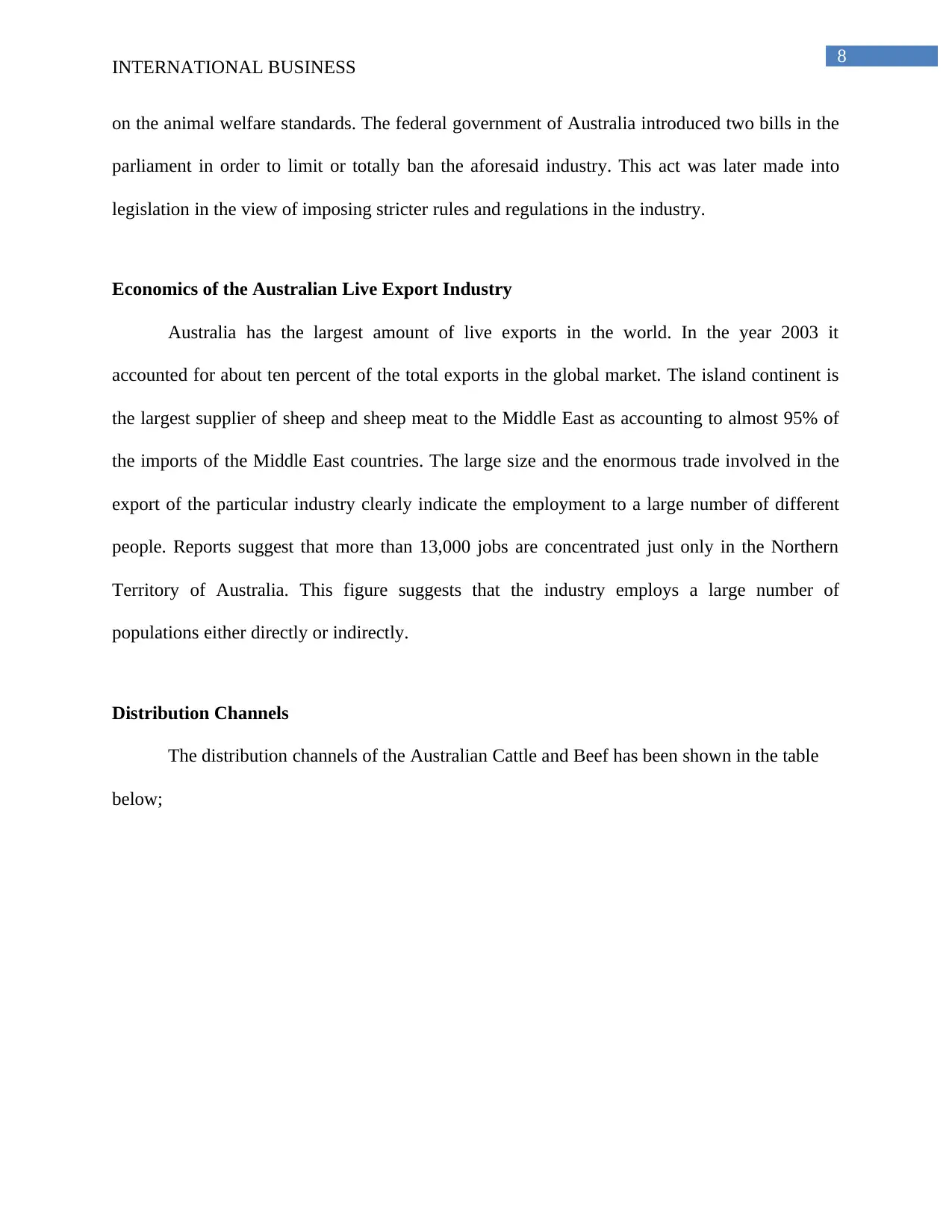
8
INTERNATIONAL BUSINESS
on the animal welfare standards. The federal government of Australia introduced two bills in the
parliament in order to limit or totally ban the aforesaid industry. This act was later made into
legislation in the view of imposing stricter rules and regulations in the industry.
Economics of the Australian Live Export Industry
Australia has the largest amount of live exports in the world. In the year 2003 it
accounted for about ten percent of the total exports in the global market. The island continent is
the largest supplier of sheep and sheep meat to the Middle East as accounting to almost 95% of
the imports of the Middle East countries. The large size and the enormous trade involved in the
export of the particular industry clearly indicate the employment to a large number of different
people. Reports suggest that more than 13,000 jobs are concentrated just only in the Northern
Territory of Australia. This figure suggests that the industry employs a large number of
populations either directly or indirectly.
Distribution Channels
The distribution channels of the Australian Cattle and Beef has been shown in the table
below;
INTERNATIONAL BUSINESS
on the animal welfare standards. The federal government of Australia introduced two bills in the
parliament in order to limit or totally ban the aforesaid industry. This act was later made into
legislation in the view of imposing stricter rules and regulations in the industry.
Economics of the Australian Live Export Industry
Australia has the largest amount of live exports in the world. In the year 2003 it
accounted for about ten percent of the total exports in the global market. The island continent is
the largest supplier of sheep and sheep meat to the Middle East as accounting to almost 95% of
the imports of the Middle East countries. The large size and the enormous trade involved in the
export of the particular industry clearly indicate the employment to a large number of different
people. Reports suggest that more than 13,000 jobs are concentrated just only in the Northern
Territory of Australia. This figure suggests that the industry employs a large number of
populations either directly or indirectly.
Distribution Channels
The distribution channels of the Australian Cattle and Beef has been shown in the table
below;
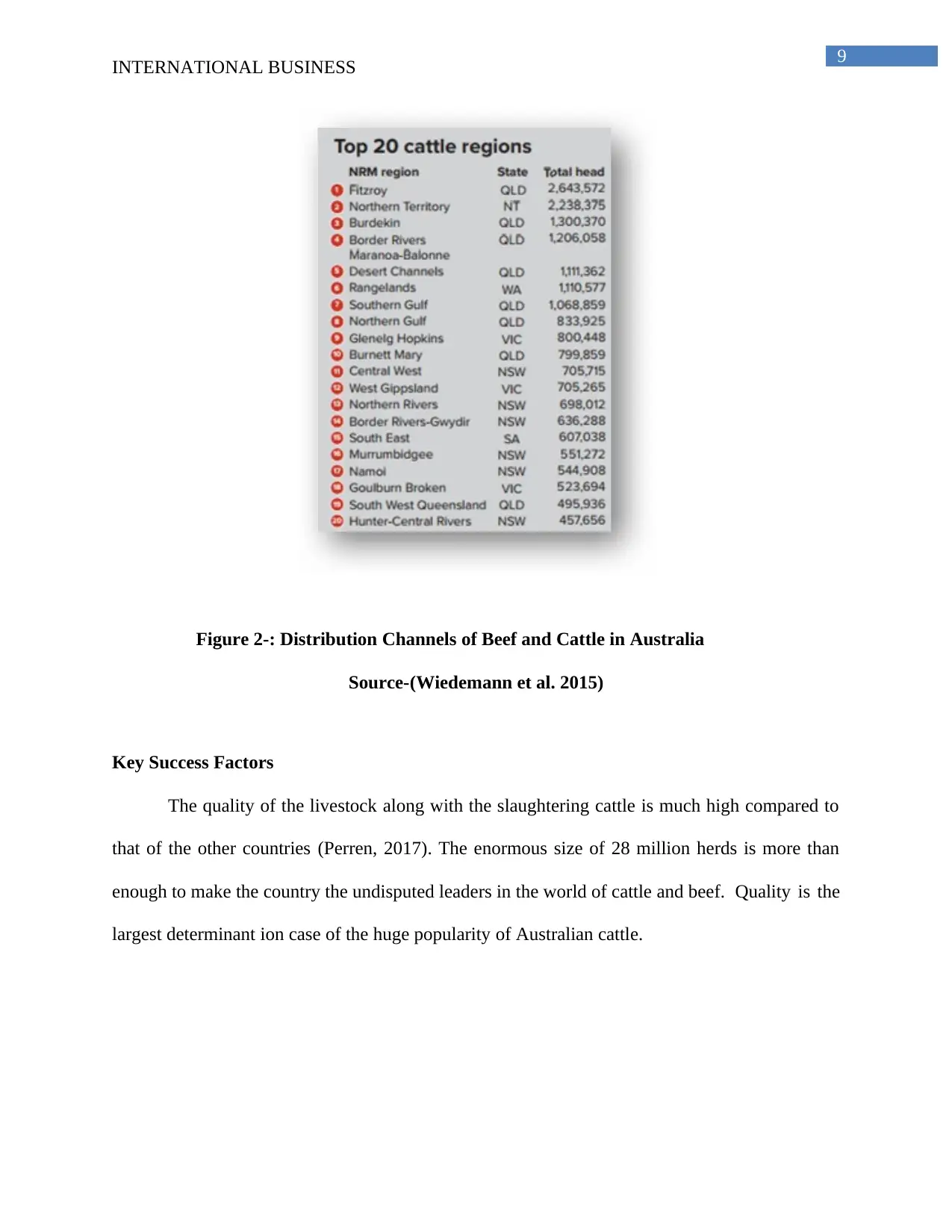
9
INTERNATIONAL BUSINESS
Figure 2-: Distribution Channels of Beef and Cattle in Australia
Source-(Wiedemann et al. 2015)
Key Success Factors
The quality of the livestock along with the slaughtering cattle is much high compared to
that of the other countries (Perren, 2017). The enormous size of 28 million herds is more than
enough to make the country the undisputed leaders in the world of cattle and beef. Quality is the
largest determinant ion case of the huge popularity of Australian cattle.
INTERNATIONAL BUSINESS
Figure 2-: Distribution Channels of Beef and Cattle in Australia
Source-(Wiedemann et al. 2015)
Key Success Factors
The quality of the livestock along with the slaughtering cattle is much high compared to
that of the other countries (Perren, 2017). The enormous size of 28 million herds is more than
enough to make the country the undisputed leaders in the world of cattle and beef. Quality is the
largest determinant ion case of the huge popularity of Australian cattle.
⊘ This is a preview!⊘
Do you want full access?
Subscribe today to unlock all pages.

Trusted by 1+ million students worldwide
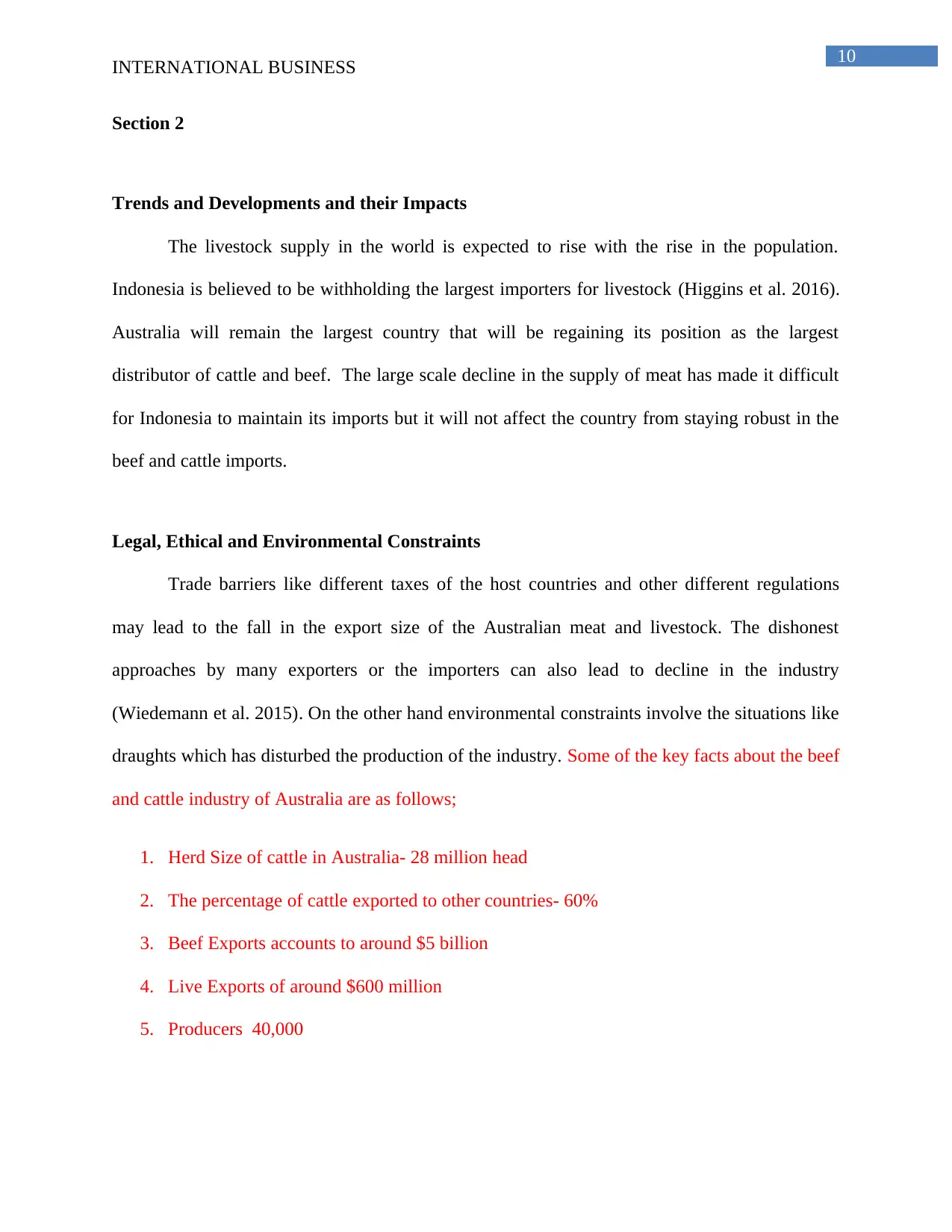
10
INTERNATIONAL BUSINESS
Section 2
Trends and Developments and their Impacts
The livestock supply in the world is expected to rise with the rise in the population.
Indonesia is believed to be withholding the largest importers for livestock (Higgins et al. 2016).
Australia will remain the largest country that will be regaining its position as the largest
distributor of cattle and beef. The large scale decline in the supply of meat has made it difficult
for Indonesia to maintain its imports but it will not affect the country from staying robust in the
beef and cattle imports.
Legal, Ethical and Environmental Constraints
Trade barriers like different taxes of the host countries and other different regulations
may lead to the fall in the export size of the Australian meat and livestock. The dishonest
approaches by many exporters or the importers can also lead to decline in the industry
(Wiedemann et al. 2015). On the other hand environmental constraints involve the situations like
draughts which has disturbed the production of the industry. Some of the key facts about the beef
and cattle industry of Australia are as follows;
1. Herd Size of cattle in Australia- 28 million head
2. The percentage of cattle exported to other countries- 60%
3. Beef Exports accounts to around $5 billion
4. Live Exports of around $600 million
5. Producers 40,000
INTERNATIONAL BUSINESS
Section 2
Trends and Developments and their Impacts
The livestock supply in the world is expected to rise with the rise in the population.
Indonesia is believed to be withholding the largest importers for livestock (Higgins et al. 2016).
Australia will remain the largest country that will be regaining its position as the largest
distributor of cattle and beef. The large scale decline in the supply of meat has made it difficult
for Indonesia to maintain its imports but it will not affect the country from staying robust in the
beef and cattle imports.
Legal, Ethical and Environmental Constraints
Trade barriers like different taxes of the host countries and other different regulations
may lead to the fall in the export size of the Australian meat and livestock. The dishonest
approaches by many exporters or the importers can also lead to decline in the industry
(Wiedemann et al. 2015). On the other hand environmental constraints involve the situations like
draughts which has disturbed the production of the industry. Some of the key facts about the beef
and cattle industry of Australia are as follows;
1. Herd Size of cattle in Australia- 28 million head
2. The percentage of cattle exported to other countries- 60%
3. Beef Exports accounts to around $5 billion
4. Live Exports of around $600 million
5. Producers 40,000
Paraphrase This Document
Need a fresh take? Get an instant paraphrase of this document with our AI Paraphraser

11
INTERNATIONAL BUSINESS
Figure 2: World and Australian Livestock Exports
Source: (Wiedemann et al. 2015)
Australian Beef Production
The availability of a large area of green and abundant pastures across the length and
breadth of the island continent makes it possible for the business persons to produce beef in the
green pastures only. However most of the beef and veal produced from the cattle are done
mainly to satisfy the needs of other Asian countries where beef is in huge demand, especially the
countries like Indonesia, Malaysia and other similar countries. The main competitive advantage
of Australia is the availability of a vast area of green pastures that ensures the production of more
amount of meat in the country (Perren, 2017).
INTERNATIONAL BUSINESS
Figure 2: World and Australian Livestock Exports
Source: (Wiedemann et al. 2015)
Australian Beef Production
The availability of a large area of green and abundant pastures across the length and
breadth of the island continent makes it possible for the business persons to produce beef in the
green pastures only. However most of the beef and veal produced from the cattle are done
mainly to satisfy the needs of other Asian countries where beef is in huge demand, especially the
countries like Indonesia, Malaysia and other similar countries. The main competitive advantage
of Australia is the availability of a vast area of green pastures that ensures the production of more
amount of meat in the country (Perren, 2017).
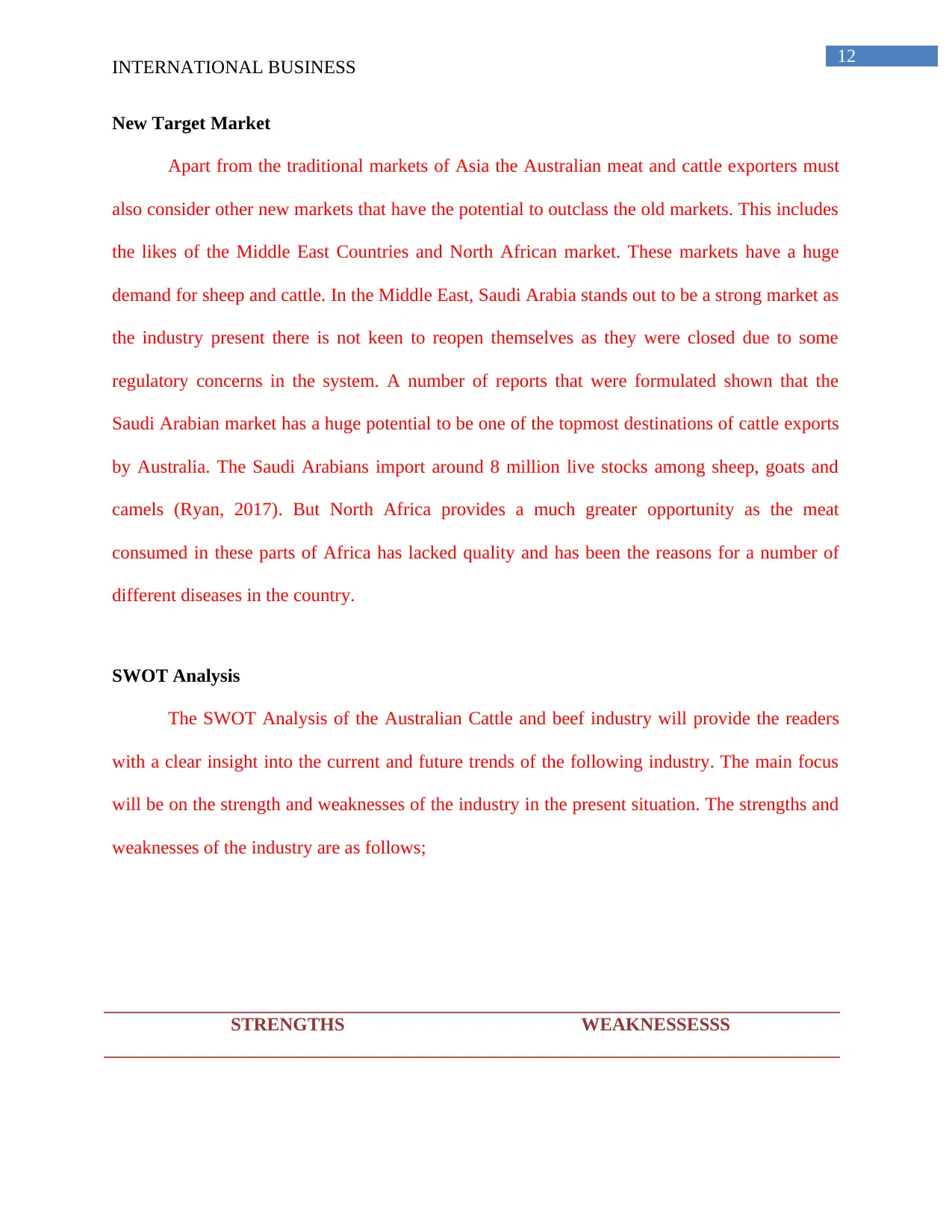
12
INTERNATIONAL BUSINESS
New Target Market
Apart from the traditional markets of Asia the Australian meat and cattle exporters must
also consider other new markets that have the potential to outclass the old markets. This includes
the likes of the Middle East Countries and North African market. These markets have a huge
demand for sheep and cattle. In the Middle East, Saudi Arabia stands out to be a strong market as
the industry present there is not keen to reopen themselves as they were closed due to some
regulatory concerns in the system. A number of reports that were formulated shown that the
Saudi Arabian market has a huge potential to be one of the topmost destinations of cattle exports
by Australia. The Saudi Arabians import around 8 million live stocks among sheep, goats and
camels (Ryan, 2017). But North Africa provides a much greater opportunity as the meat
consumed in these parts of Africa has lacked quality and has been the reasons for a number of
different diseases in the country.
SWOT Analysis
The SWOT Analysis of the Australian Cattle and beef industry will provide the readers
with a clear insight into the current and future trends of the following industry. The main focus
will be on the strength and weaknesses of the industry in the present situation. The strengths and
weaknesses of the industry are as follows;
STRENGTHS WEAKNESSESSS
INTERNATIONAL BUSINESS
New Target Market
Apart from the traditional markets of Asia the Australian meat and cattle exporters must
also consider other new markets that have the potential to outclass the old markets. This includes
the likes of the Middle East Countries and North African market. These markets have a huge
demand for sheep and cattle. In the Middle East, Saudi Arabia stands out to be a strong market as
the industry present there is not keen to reopen themselves as they were closed due to some
regulatory concerns in the system. A number of reports that were formulated shown that the
Saudi Arabian market has a huge potential to be one of the topmost destinations of cattle exports
by Australia. The Saudi Arabians import around 8 million live stocks among sheep, goats and
camels (Ryan, 2017). But North Africa provides a much greater opportunity as the meat
consumed in these parts of Africa has lacked quality and has been the reasons for a number of
different diseases in the country.
SWOT Analysis
The SWOT Analysis of the Australian Cattle and beef industry will provide the readers
with a clear insight into the current and future trends of the following industry. The main focus
will be on the strength and weaknesses of the industry in the present situation. The strengths and
weaknesses of the industry are as follows;
STRENGTHS WEAKNESSESSS
⊘ This is a preview!⊘
Do you want full access?
Subscribe today to unlock all pages.

Trusted by 1+ million students worldwide
1 out of 20
Related Documents
Your All-in-One AI-Powered Toolkit for Academic Success.
+13062052269
info@desklib.com
Available 24*7 on WhatsApp / Email
![[object Object]](/_next/static/media/star-bottom.7253800d.svg)
Unlock your academic potential
Copyright © 2020–2025 A2Z Services. All Rights Reserved. Developed and managed by ZUCOL.





